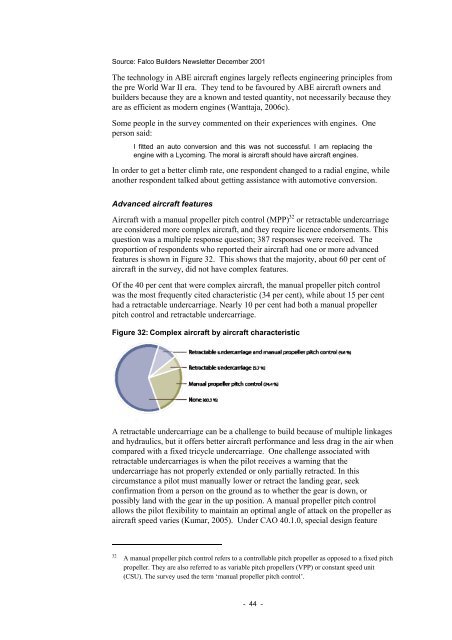Amateur-built and experimental aircraft - Australian Transport Safety ...
Amateur-built and experimental aircraft - Australian Transport Safety ...
Amateur-built and experimental aircraft - Australian Transport Safety ...
You also want an ePaper? Increase the reach of your titles
YUMPU automatically turns print PDFs into web optimized ePapers that Google loves.
Source: Falco Builders Newsletter December 2001<br />
The technology in ABE <strong>aircraft</strong> engines largely reflects engineering principles from<br />
the pre World War II era. They tend to be favoured by ABE <strong>aircraft</strong> owners <strong>and</strong><br />
builders because they are a known <strong>and</strong> tested quantity, not necessarily because they<br />
are as efficient as modern engines (Wanttaja, 2006c).<br />
Some people in the survey commented on their experiences with engines. One<br />
person said:<br />
I fitted an auto conversion <strong>and</strong> this was not successful. I am replacing the<br />
engine with a Lycoming. The moral is <strong>aircraft</strong> should have <strong>aircraft</strong> engines.<br />
In order to get a better climb rate, one respondent changed to a radial engine, while<br />
another respondent talked about getting assistance with automotive conversion.<br />
Advanced <strong>aircraft</strong> features<br />
Aircraft with a manual propeller pitch control (MPP) 32 or retractable undercarriage<br />
are considered more complex <strong>aircraft</strong>, <strong>and</strong> they require licence endorsements. This<br />
question was a multiple response question; 387 responses were received. The<br />
proportion of respondents who reported their <strong>aircraft</strong> had one or more advanced<br />
features is shown in Figure 32. This shows that the majority, about 60 per cent of<br />
<strong>aircraft</strong> in the survey, did not have complex features.<br />
Of the 40 per cent that were complex <strong>aircraft</strong>, the manual propeller pitch control<br />
was the most frequently cited characteristic (34 per cent), while about 15 per cent<br />
had a retractable undercarriage. Nearly 10 per cent had both a manual propeller<br />
pitch control <strong>and</strong> retractable undercarriage.<br />
Figure 32: Complex <strong>aircraft</strong> by <strong>aircraft</strong> characteristic<br />
A retractable undercarriage can be a challenge to build because of multiple linkages<br />
<strong>and</strong> hydraulics, but it offers better <strong>aircraft</strong> performance <strong>and</strong> less drag in the air when<br />
compared with a fixed tricycle undercarriage. One challenge associated with<br />
retractable undercarriages is when the pilot receives a warning that the<br />
undercarriage has not properly extended or only partially retracted. In this<br />
circumstance a pilot must manually lower or retract the l<strong>and</strong>ing gear, seek<br />
confirmation from a person on the ground as to whether the gear is down, or<br />
possibly l<strong>and</strong> with the gear in the up position. A manual propeller pitch control<br />
allows the pilot flexibility to maintain an optimal angle of attack on the propeller as<br />
<strong>aircraft</strong> speed varies (Kumar, 2005). Under CAO 40.1.0, special design feature<br />
32 A manual propeller pitch control refers to a controllable pitch propeller as opposed to a fixed pitch<br />
propeller. They are also referred to as variable pitch propellers (VPP) or constant speed unit<br />
(CSU). The survey used the term ‘manual propeller pitch control’.<br />
- 44 -

















